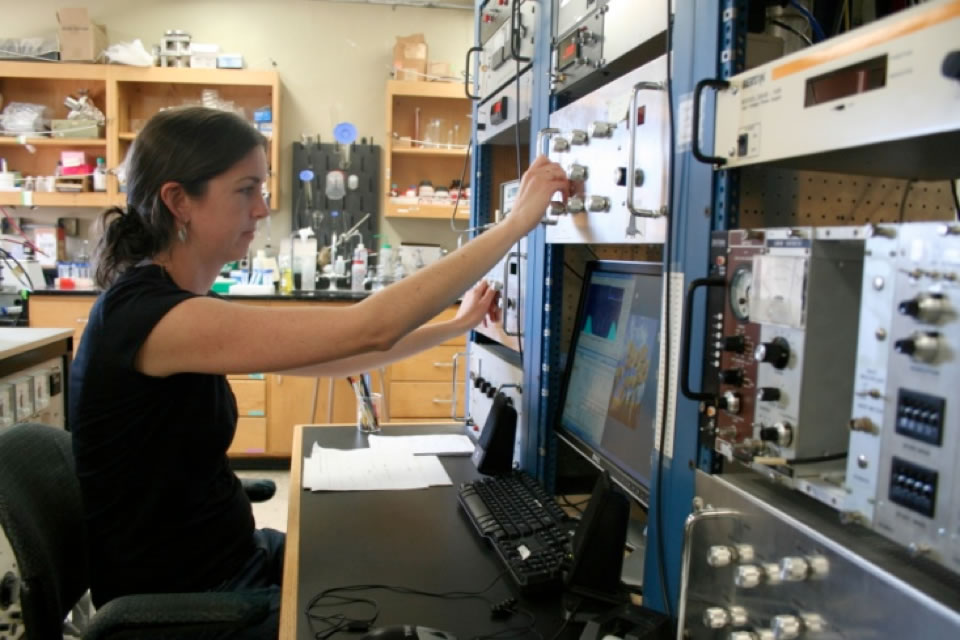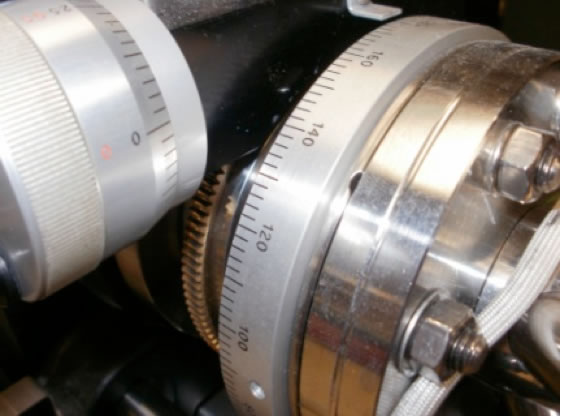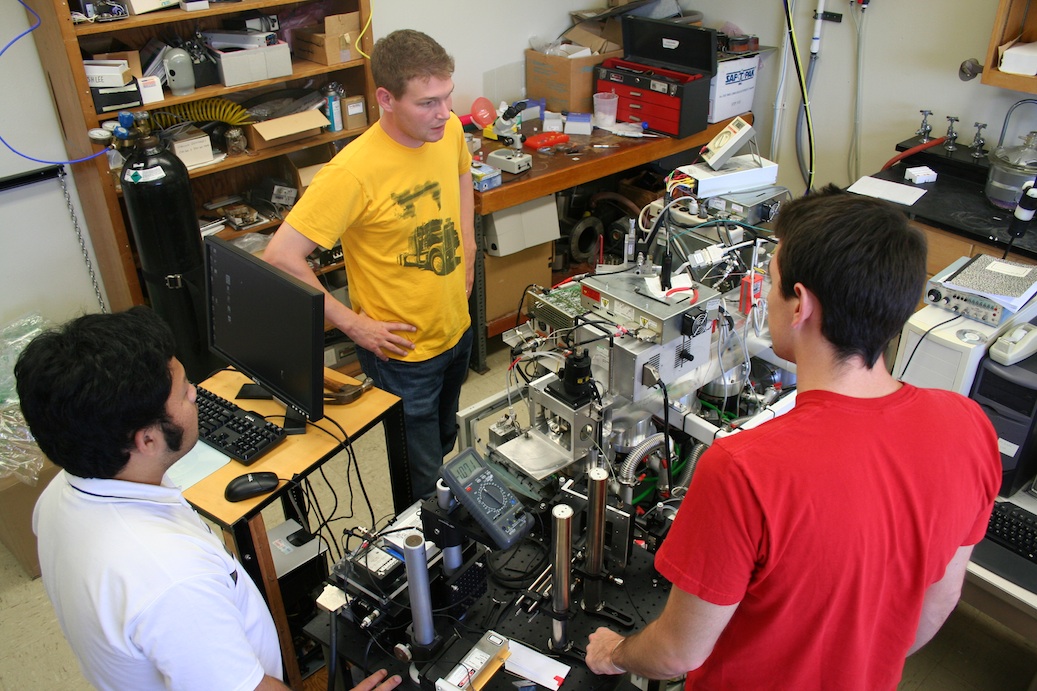Research Areas - Physical Chemistry
 The physical chemistry research area of the Department of Chemistry and Biochemistry at UCSB is home to talented scientists whose work spans a broad range of topics and disciplines, including mass spectrometry, catalysis, spectroscopy across the electromagnetic spectrum, nanomaterials, biophysics, and theoretical chemistry. Students in the physical chemistry research area have the opportunity to gain valuable training and experience through their coursework and especially in an extensive choice of cutting edge research programs.
The physical chemistry research area of the Department of Chemistry and Biochemistry at UCSB is home to talented scientists whose work spans a broad range of topics and disciplines, including mass spectrometry, catalysis, spectroscopy across the electromagnetic spectrum, nanomaterials, biophysics, and theoretical chemistry. Students in the physical chemistry research area have the opportunity to gain valuable training and experience through their coursework and especially in an extensive choice of cutting edge research programs.
A Focus on Interdisciplinary Research:
Our research regularly crosses borders, applying sophisticated physical chemical techniques to a wide variety of intriguing areas, often searching for insights at the molecular level into fundamental questions (what causes Alzheimer’s disease; what is the chemical origin of life?) and pushing the envelope in innovation (developing novel biosensors; creating new nano materials). Many of these projects involve international collaborations and combine advanced experiments with high level theory. Our students are exposed to many aspects of the exciting world of the latest research.
The interdisciplinary nature of the UC Santa Barbara’s research environment manifests itself in the fact that many faculty members in the physical chemistry division are affiliated with interdisciplinary organizations at UCSB, including the Institute for Terahertz Science and Technology (ITST), the California NanoSystems Institute (CNSI), and the Materials Research Laboratory (MRL).

The relationships fostered through these programs often lead to research collaborations with scientists in other chemistry divisions or other departments.
UCSB is also actively involved in the Partnership in International Research and Education in Electron Chemistry and Catalysis at Interfaces (PIRE-ECCI) with several universities in China. This NSF-sponsored partnership is highly interdisciplinary and allows students the opportunity to travel to China and carry out portions of their research abroad.
Additionally, students have an opportunity to become involved with the NSF-funded IGERT ConvEne (Conservation of Energy through Molecular Platforms) program, targeted at conducting research that addresses problems associated with global energy needs.
Physical Chemistry Research Faculty
- Bowers, Michael T.
Mass spectrometry of biomolecules, protein aggregation - Brown, Frank L.
Computational biophysics, single/few molecule statistics - Buratto, Steven K.
Scanning probe microscopy, fuel cells, heterogeneous catalysis, chemical imaging - de Vries, Mattanjah S.
Ultrafast spectroscopy, laser mass spectrometry, origins of life research, analysis in archeoly and art - Kirtman, Bernard
Computational chemistry, polymeric nonlinear optical properties, heterogeneous catalysis - Metiu, Horia
Computational chemistry, surface science, heterogeneous catalysis - Nguyen, Thuc-Quyen
Charge transport, nanomaterials, organic photovoltaics, devices - Plaxco, Kevin W.
Biomaterials, biophysics, electrochemistry, sensors - Scott, Susannah
Physical inorganic chemistry, catalysis, surface chemistry - Shea, Joan-Emma
Computational biophysics, molecular biochemistry, statistical mechanics, protein structure - Vlcek, Vojtech
Electronic structure and quasiparticle dynamics in nanoscale systems
Physical Chemistry Coursework
 A total of six (3-unit) classes must be taken before the student is eligible to advance to candidacy. Students in the physical chemistry division are required to take Chem 217(a) and Chem 222(a-c). Courses that are required or recommended for physical chemistry students can be found below.
A total of six (3-unit) classes must be taken before the student is eligible to advance to candidacy. Students in the physical chemistry division are required to take Chem 217(a) and Chem 222(a-c). Courses that are required or recommended for physical chemistry students can be found below.
Chem 217. Statistical Mechanics
(a) Fundamentals of statistical thermodynamics, partition functions for ideal gases and crystals, quantum statistics, calculations of thermodynamic properties.
(b) Fundamentals of non-equilibrium statistical mechanics, kinetic theory of gases, Boltzmann equation, correlation functions, linear response theory, fluctuation-dissipation theorem, Langevin and Fokker-Planck equations.
Chem 218. Photochemistry and Radiation Chemistry
Interaction of light and matter, reaction paths from electonically excited molecules, flash photolysis, high energy radiation.
Chem 219. Topics in Physical Chemistry
Special topics in physical chemistry including ultra-high vacuum technology, single molecule techniques, nonlinear optics and spectroscopy, etc. Course material varies based on instructor.
Chem 222. Fundamentals of Quantum Chemistry
(a) Introduction to quantum mechanics-postulatory approach; particle in box, on ring, harmonic oscillator; lineral operator theory, matrix algebra; hydrogen atom; perturbation theory, variation theory; applications.
(b) Molecular Orbital theory and Valence Bond theory (Secular Equation) applications to conjugated systems, electronic spectra, and term symbols; introduction to infrared, raman, and microwave spectroscopy.
(c) Introduction to NMR, EPR, group theory; applications.
Chem 225. Methods in Physical Chemistry
Fundamentals of basic measurements and advanced research instrumentation. Emphasis on both practical and conceptual understanding of the methods, suitable for experimental design. Signal electronics, vacuum techniques, molecularbeams, lasers, and optics.
Chem 245. Computational Biochemistry
Introduction to molecular modeling and molecular dynamics. Discussion of practical considerations of energy minimization, solvent modeling, structure-based drug design. Practical computer graphics experience.
Chem 248. Reaction Rate Theory
Advanced theoretical and computational methods for the analysis of reaction kinetics and mechanisms. Topics include transition state theory, Kramers' theory, tunneling effects, transition state search algorithms, transition path sampling, kinetic Monte Carlo, reaction coordinate and degree-of-rate-control analyses.


